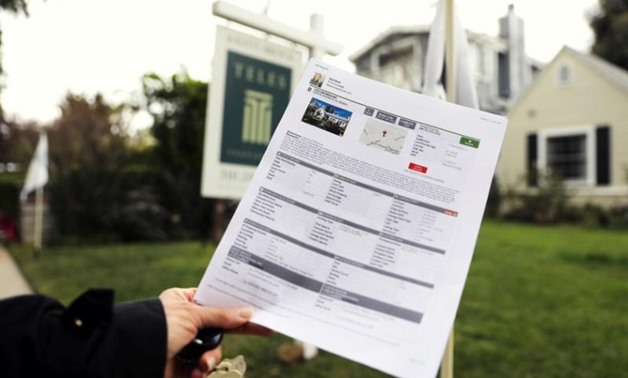
A woman holds a piece of paper advertising a home for sale in Santa Monica, California, U.S., March 21, 2017, REUTERS
WASHINGTON - 26 July 2017: New U.S. single-family home sales increased in June as purchases in the West surged to a near 10-year high, but downward revisions to the sales pace for the prior three months pointed to a housing market that is struggling to gain momentum.
New home sales slowed in the second quarter compared to the first three months of the year. The housing market is being hampered by a dire shortage of properties, which is keeping home prices elevated and sidelining first-time buyers.
"We need the housing market to be strong if the economy is to accelerate," said Joel Naroff, chief economist at Naroff Economic Advisors in Holland, Pennsylvania. "The housing market has been wandering around for most of 2017 and it isn't clear if that pattern will change anytime soon."
The Commerce Department said on Wednesday new home sales gained 0.8 percent to a seasonally adjusted annual rate of 610,000 units last month. The sales pace for March, April and May was revised lower.
New single-family homes sales in the West soared 12.5 percent to their highest level since July 2007. They jumped 10.0 percent in the Midwest, but fell 6.1 percent in the South. Sales were unchanged in the Northeast.
New home sales, which constitute 10 percent of overall home sales, rose 9.1 percent on a year-on-year basis. They remain less than half of what they were at the peak of the housing market bubble in 2005.
The slowdown in sales in the second quarter suggests housing was likely a drag on gross domestic product during that period. The sector added almost half a percentage point to the economy's annualized 1.4 percent growth pace in the first quarter.
The Atlanta Federal Reserve is forecasting GDP rising at a 2.5 percent pace in the second quarter. The government will publish its advance estimate for second-quarter GDP on Friday.
SUPPLY CONSTRAINTS
The cool-off in housing reflects constraints on supply, rather than demand, amid a strong labor market, which is near full employment. Builders are struggling to keep up with demand amid rising lumber costs and shortages of labor and land.
Housing starts are running at a 1.22 million-unit pace. That is below their historic average of 1.5 million units, a rate realtors say would eliminate the housing shortage.
About 70 percent of new homes sold in June were either yet to be built or under construction, highlighting the demand and supply imbalance.
"And this says nothing of the fact that because these homes aren't finished, they won't be move-in ready for months, meaning owners of existing homes that are moving into these new homes will not be in much rush to list their current home and sell to someone else," said Svenja Gudell, chief economist at Zillow.
A report on Monday showed sales of previously owned homes fell 1.8 percent in June.
The PHLX index of housing stocks fell on the new home sales report. Shares in the nation's largest homebuilder, D.R. Horton, declined 1.6 percent and Lennar Corp slipped 0.3 percent. Pultegroup stock fell 0.4 percent.
With homebuilder confidence dropping to an eight-month low in July, the supply of houses is unlikely to improve.
A separate report on Wednesday from the Mortgage Bankers Association showed applications for loans to purchase a home fell 2 percent last week from one week earlier to the lowest level since May.
In June, the inventory of new homes on the market increased 1.1 percent to 272,000 units, the highest level since June 2009. Still, new housing stock is less than half of what it was at its peak during the housing boom. Economists say builders have been concentrating on the construction of expensive homes.
At June's sales pace it would take 5.4 months to clear the supply of houses on the market, up from 5.3 months in May. A six-month supply is viewed as a healthy balance between supply and demand.


Comments
Leave a Comment